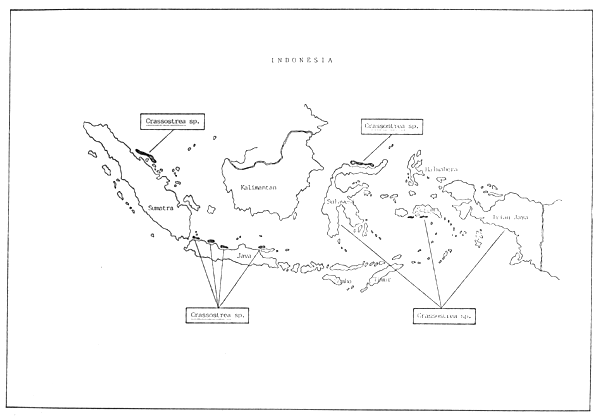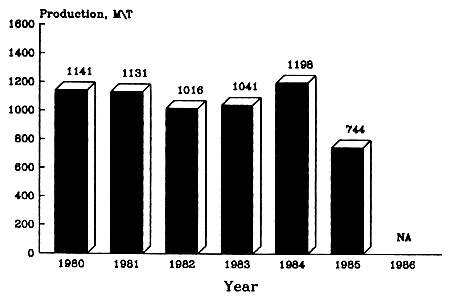Indonesia has the richest fisheries resources in the region as a
result of geographical characteristics. It is an archipelago
comprising 13,000 islands, with a very extensive coastline.
Shellfish culture in Indonesia, as with its other aquaculture
activities, is at an initial stage. Available data show that all
shellfish production comes from capture fisheries. The
production trends within the last few years show an increasing
output. In 1980 shellfish production was 35,335 MT whereas in
1984 the output was 53,577 MT, an overall increase of 52 % and
annual growth rate of about 13 %. The commercially important
bivalve species in Indonesia are mainly the flat and cupped
oysters, mussels, scallops and blood cockles.
Oyster culture in Indonesia is largely experimental at present.
Several species of oysters belonging to the Crassostrea and
Saccostrea genera are found along the coastal waters of
Indonesia.
Some small-scale culture practices of the native rock or mangrove
oyster can be observed at Kwanyan (Bangkalan) in Madura Island,
East Java.
Other areas where oysters are harvested from natural grounds are:
the Malacca Strait, north-western Java, north and south Sulawesi
and in several localities along the south coast of Seram and
Irian Jaya. (Table 5 and Fig. 8).
Oyster production data for the period 1980 to 1985 are shown in
Figure 9. The production during these years averaged about
1,000 MT per year except in 1985 when the output was 744 MT.
Total shellfish production for 1984 was 53,577 MT and oyster
production accounted only for about 2.2 % of this. Blood cockle
accounted for over 80 % of the total.
Several methods of oyster culture have been experimented in
Indonesia. The raft or floating method was tested in Bantern
Bay, Java in the early 1970's as well as the rack method in the
estuarine waters of Pamanukan, Java. The stake and rock methods
are also used.
The time of oyster spat collection varies according to the
locality, however it has been reported that the peak season at
Marunda, Jakarta, is between February-March (Unar et al., 1982).
Several kinds of cultches are used for the collection of oyster
spat, the traditional one being made out of empty oyster shells
strung together. Cement coated roof tiles have been tested and
proved satisfactory.
Harvesting of commercial size (6–8 cm) oysters occurs after 6–7
months.
So far, shellfish culture in Indonesia has not developed mainly due to health hazards and consumer preferences. No sanitary control is imposed on captured bivalves. Although the great majority of capture and potential culture sites are pollution-free it is felt that some means of quality control should be developed in order to stimulate demand. With regard to consumer food preferences, seafood does not constitute the daily diet of all Indonesians; only a few regions of the country, such as south Sulawesi, Maluku and Irian Jaya give preference to seafood, whereas in the remaining regions vegetables are preferred to fish or meat. For these two reasons there is a low market demand for shellfish and little incentive to invest in shellfish culture.
The Indonesian Government is trying to promote coastal
aquaculture and several species of shellfish have been introduced
for culture. The Seafarming Development Project, supported by
UNDP and FAO, is working on the introduction and development of
seafarming systems and technologies applicable to Indonesia.
In order to promote shellfish culture in Indonesia, it has been
recommended that the agencies concerned should concentrate on the
following (Juntarashote et al., 1987):
Market promotion. Due to its limited market, promotion of shellfish should be encouraged to induce people to consume more of the product. The public should be made aware of the nutritional value of bivalve species and provided with cooking recipes.
Production of good quality shellfish. One of the main reasons why the market is limited is the low quality of shellfish. To avoid hazards due to environmental pollution, suitable culture areas should be identified and carefully selected. These should be free from contamination arising from household and industrial wastes.
Introduction of culture technologies. The introduction and adoption of culture technologies from countries with longer culture traditions would certainly aid the development of the young industry.
Table 5. Distribution and main culture areas of commercially important oyster species in Indonesia.
| SPECIES | PROVINCE | LOCALITY | NOTES |
| Crassostrea sp. Saccostrea sp. | Sumatra | Malacca Strait | Exploitation of natural fisheries and small-scale culture practices. |
| Java | Bangkalan (Madura Island), Bantern Bay, Pamanukan Estuary, Maruda | Exploitation of natural fisheries and small-scale culture practices. | |
| Sulawesi | Both north and south Sulawesi | Exploitation of natural fisheries and small-scale culture practices. | |
| Seram | Maluku | Exploitation of natural fisheries and small-scale culture practices. | |
| Irian Jaya | -- | Exploitation of natural fisheries and small-scale culture practices. |

Figure 8: Major oyster capture and culture areas in the Indonesian archipelago.

Figure 9: Oyster (Crassostrea sp. and Saccostrea sp.) production data in Indonesia from 1980 to 1985. (Source: Fisheries Statistics of Indonesia, 1985. SEAFDEC Fishery Statistical Bulletins for the South China Sea Area).